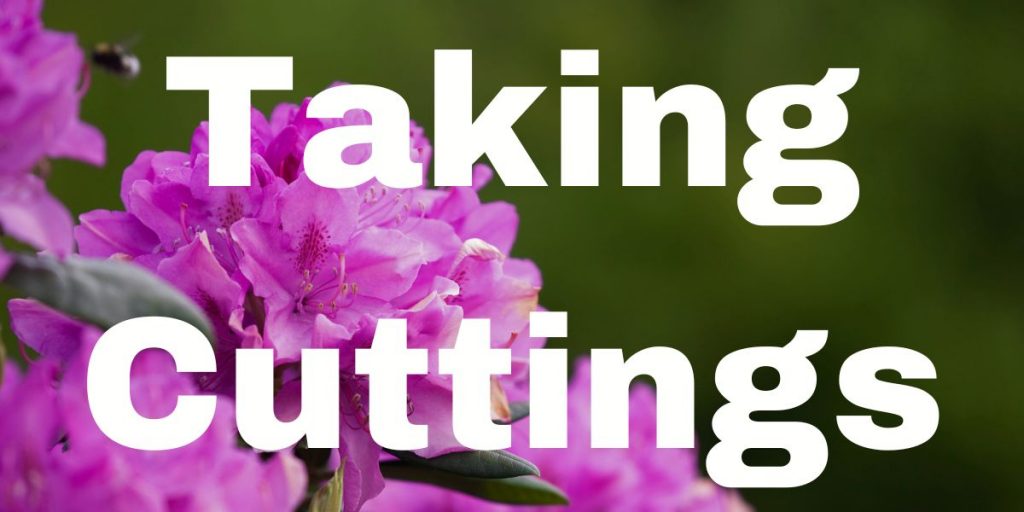Summer & Winter Cuttings
Summer or winter are the best times to take cuttings of rhododendrons, camellias, azaleas and most other broad-leaf evergreens. Cuttings properly taken will usually produce flowering sized plants in about three or four years.
Rooting medium, moisture, exposure and correct timing will be the key factors in having success with cuttings.
To start plants from cuttings is fun, but time consuming, unless a greenhouse or cold frame is used. If time is an element, the best answer is to buy an already started, older plant, which is flowering size.
I like to take cuttings during the cool morning hours and then let them sit in water for a couple of hours before placing them in the starting mix. This helps condition and harden them off.
As you take your cuttings, be careful not to ruin the appearance of the plant that you are taking the cuttings from. Do not make the mistake of leaving stub ends of branches that are apt to die-back during a cold winter. In other words, keep basic pruning procedures in mind as you are taking your cuttings.
New growth that has matured about sixty to ninety days is best for taking cuttings of broad-leaf evergreens. The most common mistake is to try to root too large a cutting. Generally, it is taken just below the third, fourth or fifth leaf, making it two to six inches long, depending upon the-type of plant.
Be sure to use a sharp knife or you are apt to leave-a ragged cut on your plant and on the cutting. Make the cut at a slight slant. Then remove the lower leaves, just leaving the tip ring of foliage growth. With the larger-leafed evergreens like rhododendrons, it is necessary to cut off one third to one-half of the tip of the foliage. This cuts down on water loss through the leaf and also helps to conserve space in the pot or flat.
To help stimulate root development, it is then a good practice to dip about one inch of the cut end of your cutting into a rooting hormone. Gently tap the cutting to shake off any excess solution.
Now the cutting is ready to be set into a planting or rooting medium. You will find a wide selection of recommended material available. Some gardeners use one hundred percent, coarse, fresh-water sand; others use one hundred percent peat moss, vermiculite or sponge rock; still others will use a combination of fifty percent peat moss and fifty percent sand, vermiculite or sponge-rock. I suggest that you experiment a little to see which combination is best for you. I have best results with fifty percent each of peat moss and coarse sand.
You can use flats, pots, trays or even cut off milk cartons for starting your cuttings. Remember, proper drainage will be an important factor in whether the cuttings root and develop, so select a container that has good drainage. That is why pots and flats are generally used for the job.
The cuttings are placed in the rooting medium, about an inch or two apart. Again, this is determined by the leaf size of the cutting. With a finger, pencil or similar-sized stick, press a hole in the rooting medium. The hole should be about an inch deep for small cuttings and an inch and a half to two inches deep for larger cuttings. Then, simply place the cutting in the hole and, with your finger, press the rooting medium up firmly around it.
Keep the container moist, but not wet, until the cutting takes hold.
Placement of the cuttings depends upon available sites. Possible choices would be the greenhouse, cold frame, basement or outdoors. Because I do not have a greenhouse I prefer to set my cuttings outside in the shrub beds, where they get plenty of daylight but only filtered sunlight. When the weather cools in mid-September or early October bring the cuttings indoors and place them in the basement or garage.
The time it takes cuttings to root varies considerably between types of plants. However, most of the cuttings will take hold and root within sixty to ninety days and generally less time in the greenhouse.
Cuttings taken in early August are ready to be potted into individual pots around the first part of November. Two and one half to four-inch pots should be used to plant individual cuttings. You can use a commercial potting soil mix or a combination of one-third sandy loam soil, one-third fresh-water sand and one third peat moss for your potting soil. Set the cuttings right at the same level as they were in the flats and firm the soil around them. Be careful at all times not to damage the rather fragile new roots.
Place the pots in the same location as the cuttings had been. Keep the pots watered regularly throughout the winter months.
In May of next- year, or when all danger of frost has passed, the new plants are ready to be set out in the garden, in their permanent planting spot. Again, be careful to set the plant right at ground level. It may be necessary to provide shade for young plants during hot weather for the first season. Likewise, winter protection may be necessary the first winter the new plants are in the garden.
